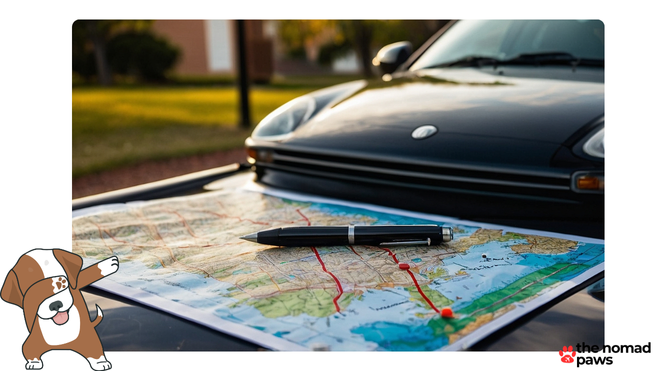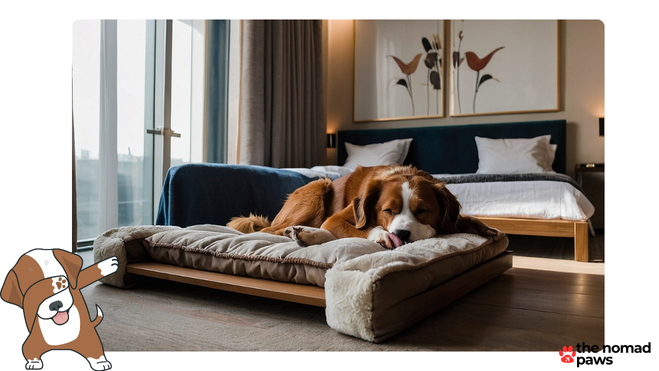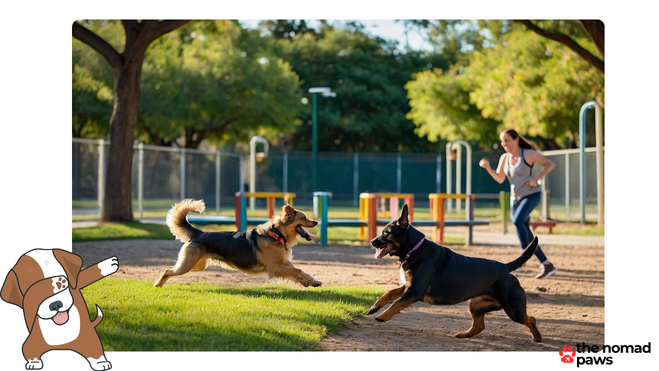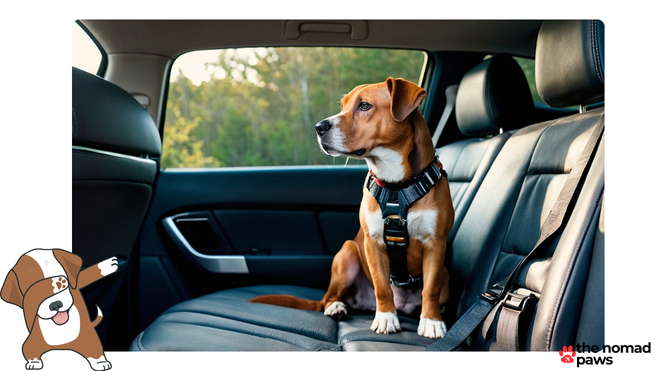Ah, the open road! There’s nothing quite like the thrill of embarking on a grand adventure with your four-legged best friend by your side.
But let’s face it, planning a dog-friendly road trip can be a bit like trying to teach your pup to use the TV remote – tricky, but not impossible.
Fear not, fellow pet parents! We’ve fetched all the best tips and tricks to ensure your canine companion has just as much fun as you do on your next journey.
Dreaming of a cross-country expedition or a weekend getaway? This ultimate dog-friendly road trip planner will have you and your furry co-pilot ready to hit the highway in no time.
So buckle up (your pup too!), and let’s dive into the world of tail-wagging travels!
Preparing for Your Journey

Before you start packing the car and practicing your road trip playlist, there’s some important prep work to be done.
After all, a well-planned trip is like a well-trained dog – it makes everything so much easier!
Essential Items for Dogs on Road Trips
Just like you wouldn’t leave home without your phone charger or favorite snacks, your pup has their own list of must-haves for the journey.
Let’s break it down into the essentials:
Food and Water Supplies
First things first – we all know how cranky we get when we’re hungry, and dogs are no different!
Pack enough of your dog’s regular food to last the entire trip, plus a little extra for good measure.
Don’t forget to bring dog travel essentials like their favorite bowls, a can opener if needed, and any supplements they usually take.
Bring a generous supply of fresh water and a portable dog water bowl for easy access during pit stops.
Pro tip: Freeze some water bottles before you leave – they’ll keep your cooler chilled and provide a refreshing drink as they melt.
Comfort Items (Beds, Toys, Blankets)
Home is where the heart is, and for your dog, that might just be wherever their favorite blanket happens to be.
Pack familiar bedding to create a cozy spot in the car and at your accommodations. You can also find dog calming techniques using Adaptil Transport spray to help ease your pet’s anxiety during the trip.
Throw in a few beloved toys to keep them entertained and help them feel secure in new environments.
Don’t forget the power of scent!
A toy or blanket that smells like home can work wonders in calming an anxious traveler.
Just make sure whatever you bring is washable – road trips have a way of getting messy!
Safety Equipment (Harnesses, Crates)
Safety first, folks! A proper restraint system is non-negotiable when it comes to dog in travel trailer while driving.
Whether you opt for a crash-tested harness that attaches to the seat belt or a secured crate, make sure your pup is protected in case of sudden stops or accidents.
If you’re using a carrier, the k9 sport sack knavigate review might give you some ideas on what to look for in a comfortable and secure option.
Remember, a safe dog is a happy dog (and a less stressed human)!
First Aid Kit for Dogs
Hope for the best, but prepare for the worst – that’s the motto of savvy pet travelers.
Put together a canine-specific first aid kit including:
- Gauze and self-adhering bandages
- Tweezers for removing ticks or splinters
- Styptic powder to stop bleeding from minor cuts
- Any medications your dog takes regularly
- Your vet’s contact information and the numbers of emergency clinics along your route
Pre-Trip Veterinary Check-up

Before you embark on your grand adventure, schedule a check-up with your veterinarian.
This is especially important if you’re planning a long trip, if you have a senior dog, or if your dog hasn’t traveled much before.
Your vet can ensure your pup is healthy enough for travel and up-to-date on all necessary vaccinations.
This is also a great time to discuss any travel-specific concerns, such as motion sickness or anxiety.
Your vet might recommend medications or natural remedies like pheromones calming collars to make the journey smoother for your four-legged friend.
Updating ID Tags and Microchip Information
Last but certainly not least, make sure your dog’s identification is current.
Update ID tags with your cell phone number and consider adding a temporary tag with your travel information.
If your pup is microchipped (and they should be!), check that the registration details are up to date.
Remember, in the hustle and bustle of travel, even the most well-behaved dogs can get lost.
Proper identification is your best bet for a happy reunion if your furry explorer decides to go on an unplanned solo adventure.
Planning Your Route

Now that you and your pup are prepped and ready, it’s time to map out your epic journey.
Planning a dog-friendly route is like piecing together a puzzle – it takes a bit of effort, but the result is a beautiful picture of adventure!
Pet-Friendly Accommodations Along the Route
Finding a place to rest your head (and paws) is crucial for any road trip. Let’s explore your options:
Hotels and Motels

Many hotel chains have caught onto the fact that we love traveling with our furry friends.
Brands like Kimpton, La Quinta, and Motel 6 are known for their pet-friendly policies. However, always call ahead to confirm their current pet policy, as rules can change.
When booking, ask about any size limitations, additional fees, or specific pet policies.
Some hotels might restrict the number of pets per room or have designated pet-friendly floors. And remember, just because a hotel allows pets doesn’t mean they cater to them – you might need to bring your own dog bed or food bowls.
Vacation Rentals
Platforms like Airbnb and VRBO often have a wider range of pet-friendly options, from cozy apartments to sprawling houses with fenced yards.
These can be great for longer stays or if you’re traveling with multiple pets.
When browsing listings, use the pet-friendly filter and read the house rules carefully.
Some hosts might have specific requirements, like proof of vaccinations or an additional cleaning fee for pets.
Campgrounds
For the more adventurous duos, camping can be a fantastic option. Many campgrounds welcome four-legged guests, but policies can vary widely.
Some might require leashes at all times, while others have off-leash areas or even dog parks.
If you’re new to camping with your pup, check out this handy camping with a dog checklist to ensure you’ve got all the essentials covered.
Planning a trip to the Centennial State? Make sure you check out the best dog-friendly campgrounds in Colorado first!
Nearby Dog Parks and Off-Leash Areas

All work and no play makes for a dull road trip!
Research dog parks and off-leash areas along your route for some much-needed stretch and play sessions. Apps like BringFido can be invaluable for finding these canine oases.
When planning your stops, aim for a good romp every few hours.
This not only helps your dog burn off energy but also gives you both a chance to enjoy some fresh air and maybe even meet some local pups!
Pet-Friendly Dining Options During the Journey

Who says dogs can’t enjoy a good meal out? Many restaurants, especially those with outdoor seating, welcome well-behaved pooches.
Look for places with dog-friendly patios or even special “yappy hour” events.
If you’re unsure about local regulations, call ahead or check online reviews from other pet owners.
And always be prepared with a backup plan – a picnic in a nearby park can be just as enjoyable (and often more relaxing) for both you and your furry dining companion.
Here on the Nomad Paws we do our best to find the top places where both you and your pup can enjoy a meal together.
Need some tips? Check out these lists:
- Where to Eat with Your Dog in Prescott, Arizona
- Where to Eat with Your Dog in Bend, Oregon
- Where to Eat with Your Dog in Salt Lake City
- Where to Eat With Your Dog in Charleston, SC
- Where to Eat with Your Dog in Sedona
- Where to Eat with Your Dog in Michigan: Our Picks
Breed-Specific Regulations in Travel Areas

Here’s something many pet owners overlook: some areas have breed-specific legislation that could affect your travel plans.
If you have a breed that’s sometimes subject to restrictions (like pit bulls or certain large breeds), do your homework before hitting the road.
Check local regulations for any areas you plan to visit or pass through.
This is especially important if you’re crossing state or country borders.
A little research can save you a lot of heartache down the road.
On the Road

You’ve planned, you’ve packed, and now it’s time to hit the open road!
But how do you keep your furry co-pilot happy and comfortable during those long stretches of highway?
Let’s dig into some road-tested tips for a smooth journey.
Keeping Dogs Comfortable on Long Car Rides
Just like us humans, dogs can get a bit antsy on long car rides.
The key is to create a space that’s as cozy and familiar as possible.
Creating a Cozy Space in the Car

Think of your car as a home away from home for your pup. If you’re using a dog crate for travel, make sure it’s large enough for your dog to stand up, turn around, and lie down comfortably.
Line it with their favorite blanket or bed for extra comfort.
If your dog is riding in the backseat, consider using a hammock-style seat cover.
This not only protects your car but also gives your dog a cozy, den-like space.
Add some familiar toys or a piece of clothing with your scent to help them feel secure.
Temperature Control
Dogs can’t regulate their body temperature as efficiently as we can, so keeping the car at a comfortable temperature is crucial.
Aim for a temperature between 68-72°F (20-22°C) for optimal comfort.
If you’re traveling in hot weather, never leave your dog alone in the car, even for a few minutes.
The temperature inside a vehicle can rise dangerously fast, even on mild days.
Is it ok to leave a dog in a hot car? The answer is a resounding no – it’s not just uncomfortable, it can be life-threatening.
Hydration Tips
Keeping your pup hydrated on the road is crucial, but it can be tricky.
Offer water at every stop, even if your dog doesn’t seem thirsty.
Some dogs may be hesitant to drink in unfamiliar surroundings, so bringing their usual water bowl can help.
For dogs prone to car sickness, limit water intake right before and during car rides, but increase frequency of water breaks instead. And remember, if you’re thirsty, your dog probably is too!
Scheduling Bathroom and Exercise Breaks for Dogs
No one likes a cross-legged car ride, least of all our four-legged friends.
Regular breaks are essential for your dog’s comfort and well-being.
As a general rule, plan for a break every 2-3 hours for adult dogs, and more frequently for puppies or senior dogs.
This gives your pup a chance to stretch their legs, do their business, and reset for the next leg of the journey.
Remember, these breaks are good for you too!
Use this time to stretch, grab a snack, and enjoy a bit of fresh air.
It’s amazing what a quick game of fetch can do for both your moods!
Finding Safe Areas for Breaks
When choosing your pit stops, look for areas that are safe and dog-friendly.
Rest areas often have designated pet relief areas, but be cautious – these can be hotspots for parasites or diseases from other traveling pets.
To keep your pup safe, make sure to bring a tick and flea collar. If you need a new one, check out our analysis – we’ve compared different brands to find the best flea and tick collar for dogs.
If possible, seek out local parks or green spaces for your breaks.
This gives your dog a chance to explore new smells and burn off some energy. Just remember to always clean up after your pet and follow local leash laws.
Managing Dog Carsickness and Anxiety While Traveling

For some dogs, car rides are more stressful than fun. But don’t worry – there are ways to make the journey more comfortable for anxious or carsick pups.
Recognizing Signs of Distress
Keep an eye out for signs of anxiety or motion sickness in your dog. These can include:
- Excessive drooling
- Whining or barking
- Restlessness or inability to settle
- Vomiting or dry heaving
If you notice these signs, it’s time to take action to help your furry friend feel better.
Natural Remedies and Medications
For mild cases of anxiety or motion sickness, natural remedies like ginger cookies or lavender essential oil (used safely, of course) can help.
Some pet parents swear by products like Thundershirts, which provide gentle pressure to calm anxious dogs.
For more severe cases, your vet might recommend anti-nausea medication or mild sedatives.
Always consult with your veterinarian before giving your dog any new medications or supplements.
Calming Techniques
Sometimes, a little TLC goes a long way. Try these calming techniques:
- Play soft, soothing music
- Use pheromone sprays designed to calm dogs
- Take more frequent breaks for short walks and reassurance
Remember, staying calm yourself can help your dog feel more relaxed.
Your furry friend picks up on your emotions, so if you’re stressed, they’re more likely to be stressed too.
Ensuring Dog Safety During Road Trips

Safety should always be your top priority when traveling with your four-legged friend.
Let’s dive into some crucial safety measures to keep your pup protected on the road.
Proper Restraint Methods
Just as you wouldn’t dream of driving without your seatbelt, your dog needs proper restraint too.
Not only does this keep your pup safe in case of sudden stops or accidents, but it also prevents them from distracting the driver.
There are several options for safely restraining your dog in the car:
- Harnesses and Seat Belts: These attach to your car’s existing seat belt system and allow your dog some movement while keeping them secure. Look for options that have been crash-tested for safety like this one by VavoPaw.
- Crates or Carriers: A sturdy, well-ventilated crate can provide a safe space for your dog. Make sure it’s large enough for your dog to stand, turn around, and lie down comfortably. Secure the crate so it doesn’t slide around during the drive.
- Barriers: For larger vehicles, a dog barrier between the back area and the passenger seats or a simple net barrier can keep your dog from jumping into the front. However, this should be used in conjunction with a harness or crate for maximum safety.
Remember, the back seat is the safest place for your dog. Airbags can be dangerous for pets in the front seat, just as they are for small children.
Never Leaving Dogs Alone in the Car
We’ve touched on this before, but it bears repeating: never leave your dog alone in the car, especially in warm weather.
Even on a mild day, the temperature inside a car can rise to dangerous levels in just minutes.
If you need to make a stop where dogs aren’t allowed, take turns with your travel companions to stay with the dog, or look for pet-friendly alternatives.
Many rest stops and gas stations have shaded areas where you can safely walk your dog while someone else runs inside.
Monitoring for Heat Exhaustion
Dogs are more susceptible to heat exhaustion than humans, so it’s crucial to keep an eye out for signs of overheating, especially during summer road trips.
Symptoms of heat exhaustion in dogs include:
- Excessive panting or drooling
- Reddened gums
- Vomiting or diarrhea
- Dizziness or lack of coordination
- Collapse
If you suspect your dog is suffering from heat exhaustion, move them to a cool area immediately, offer small amounts of water, and contact a veterinarian.
Prevention is key – ensure your car is well-ventilated, never leave your dog in a parked car, and provide plenty of fresh water.
Emergency Preparedness
Hope for the best, but prepare for the worst. Here are some emergency preparedness tips:
- Research emergency vets: Before your trip, make a list of emergency veterinary clinics along your route and at your destination.
- Pack a pet first-aid kit: Include items like gauze, antiseptic wipes, tweezers, and any medications your dog takes regularly.
- Keep important documents handy: Bring copies of your dog’s medical records, vaccination history, and a recent photo (in case they get lost).
- Consider pet insurance: If you don’t already have it, pet insurance can provide peace of mind for unexpected veterinary expenses while traveling.
Being prepared doesn’t mean you’re expecting something to go wrong – it just means you’ll be ready if it does!





